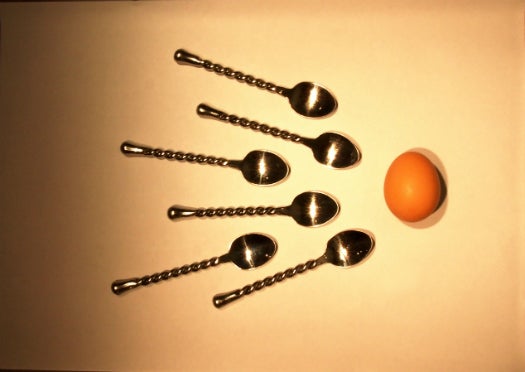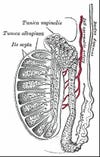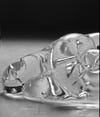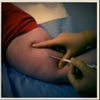Click here to enter the gallery
Male birth control, like flying cars, just seems like one of those things we should have by now. It’s the 21st century—if they can find the Higgs Boson and bring back Arrested Development, shouldn’t they be able to come up with a birth control option for men that isn’t a condom or a vasectomy?
It’s hardly for lack of trying. There’s the classic “men have millions of sperm, but women have only one egg” argument, but that’s far from the only challenge. For a long time, it was widely assumed that men just wouldn’t be interested, though research has since proved that assumption wrong.
“I think largely, it was a generational shift, too,” says Elaine Lissner, director of the Male Contraception Information Project (MICP). “Once the Baby Boomers came into power, there was more openness to the concept, versus the generation before the Baby Boomers.”
Interest in the scientific community has grown to the point that the National Institute of Child Health and Human Development (NICHD) has hosted several conferences on developing male birth control methods. But pharmaceutical companies are the ones that will need to show interest in order for something to really get off the ground. And they’ve been largely hesitant, so far. Unlike a drug for, say, cancer, birth control ostensibly would be used by otherwise healthy men, which means there’s a much higher bar for safety.
“I see it as they’re just not willing to put their toe in the water,” says Diana Blithe, program director for the Contraceptive Development Research Centers Program and the Male Contraceptive Development Program at the NICHD. “But if there was a prototype on the market, I think others would come relatively quickly. It’s just [that] getting the first [one] all the way through the hurdles is a relatively long process. And it’s not something that they see as an immediate return on their investment. I think that it’s something that you really have to have a long vision for and companies tend not to have a very long vision… Nothing is going to get to market soon.”
But the biggest challenge is that even among those pursuing male birth control, no one can seem to agree on the best way to do it. Everyone I talk to tells me three more methods I should look into. Pills, injections, implants or procedures? Hormonal or non-hormonal? After talking to many researchers and experts in the field, I compiled eight different male contraception methods that are currently in development and outlined the cost, convenience, effectiveness, reversibility and status of each, in the gallery above.
Ultrasound
What is it? Treating the testes with therapeutic ultrasound has been shown to reduce sperm production. Though there is heat produced by the treatment, the ultrasound causes more sperm loss than just applying heat, though researchers don’t know why. A team at the University of North Carolina at Chapel Hill tested this method on rats, and was able to reduce their sperm count tenfold with the application of a 3 MHz ultrasound. Cost: The only costs would be a therapeutic ultrasound system ($2,000) and the wages of the person providing the treatment. “I imagine it could be priced similarly to a short office visit with a health care professional at a clinic,” says James Tsuruta, lead research on the UNC study. Convenience: The procedure is quick, painless and a single treatment could provide lower sperm counts for up to six months, though that remains to be confirmed with studies on human men. Effectiveness: Under certain conditions, the team was able to keep all cells in the testes from undergoing meiosis. Reversibility: Unclear. Studies done on animals in the 1970s showed that with a low dose of ultrasound, fertility could return within six months, but if it was too high, the sterility was permanent. Tsuruta’s team’s study on rats did not test reversibility; he says more experiments on animals are needed to figure out the perfect dose. Status: The team has planned experiments to learn about the length of the contraceptive effect, what the minimum effective treatment is and what any side effects might be. They are currently seeking funding for these experiments.
RISUG
What is it? RISUG stands for Reversible Inhibition of Sperm Under Guidance. During the minimally invasive procedure, a mixture of dimethyl sulphoxide and the copolymer styrene maleic anhydride is injected into the vas deferens, where, upon interacting with bodily fluids, it generates an electrical charge. This charge negates the normal negative charge of the sperm’s membrane and causes it to disintegrate, as pictured at left. Cost: The cost of a RISUG procedure for one man is about 10,000 rupees, or about $20. Convenience: One injection could be effective for up to 10 years. Scheduling one office visit would be the only inconvenience. Effectiveness: According to lead researcher Sujoy Guha, as long as the drug is injected correctly, it’s 100 percent effective. Reversibility: The procedure can be reversed by injecting a solvent such as sodium bicarbonate into the vas deferens, or through a non-invasive procedure that involves massage, mechanical vibrations and an electrical stimulus. Status: “In India we have been testing human volunteers since 1990 with very good results,” says Guha. He expects to see limited marketing approval in India later this year. In the U.S., a version of RISUG called Vasalgel is currently being developed (described in more detail on the next page).
Vasalgel
What is it? Vasalgel works in essentially the same way as RISUG—an injection into the vas deferens with the active ingredient styrene maleic anhydride, which disrupts the sperm’s membrane as it passes through the vas deferens, killing it. However, “it has different synthesis (catalyst), purification, formulation, molecular weight and other elements that make it quite different in many ways,” says Gary Gamerman, president of Seraphim Life Sciences. Gamerman is in charge of manufacturing and regulatory issues for Vasalgel. Cost: “The cost will be competitive with [a] vasectomy,” Gamerman says. For less developed regions, the team hopes to get the cost below $10 a patient. Convenience: Like RISUG, one office visit is all it takes for long-term, worry-free contraception. Effectiveness: Sujoy Guha, RISUG’s developer, claims that it is 100 percent effective. The Vasalgel team doesn’t offer a percentage, but Ron Weiss, who is on Vasalgel’s medical advisory board says “studies indicate an efficacy similar to vasectomy, which is the most effective and reliable form of permanent contraception.” Reversibility: Researchers have successfully shown reversibility in animals, but it still needs to be addressed in human tests. Status: “Vasalgel is in preclinical animal testing, with a plan to move quickly to human studies,” Gamerman says. The team is hoping to get it approved by regulators within three to five years.
Contraceptive Gel
What is it? Progestin and testosterone hormones in gel form that the user rubs into the skin. The progestin suppresses testosterone production and therefore spermatogenesis, and the testosterone is added back in to take care of all the things natural testosterone normally would, like libido and muscle mass. Cost: Expensive. The gel would cost the user between $5-$10 a day. Convenience: The gel is applied like sunscreen to the skin once daily, making it fairly easy to administer, though perhaps not quite as convenient as just taking a pill. Men would have to be careful to keep the gel away from women, who could suffer hair growth and other effects of virilization, and children, lest they undergo an early puberty, according to John Amory of the University of Washington. Effectiveness: The gel is 85 percent effective, about 14 percent less effective than women’s hormonal birth control pills, which are more than 99 percent effective if taken correctly. Reversibility: Easily reversible. Stop using the gel, and your swimmers return to full strength. Status: The team at the National Institute of Child Health and Human Development (NICHD) is analyzing the data, and determining the logistics of doing another trial. Up to now, the progestin and testosterone have been separate; now the team wants to try combining them into one gel.
Gamendazole
What is it? A non-hormonal pill that targets sperm’s motility. Developed by Joseph Tash at the University of Kansas and his team, the compound gamendazole reduces sperm’s ability to swim. “Sperm needs to be very motile to move up to the egg and penetrate the egg and if sperm are sort of paralyzed, that can’t happen,” says Gunda Georg, who was involved in developing the pill at Kansas and has since moved to the University of Minnesota. Cost: It’s too early to know for sure, but Georg says she expects the cost to be reasonable, in part because the drug is fairly simple to make—”It only takes about five chemical steps to prepare,” she says. Convenience: The team is still working out the exact dosage and how often it would need to be taken. It’s possible that it could be a daily dose, like the female hormonal pill, but it could also be a weekly dose. Effectiveness: In tests on rats, 100 percent of the animals were sterile after taking the drug, Georg says. Reversibility: At least in rats, when the animals stopped taking the drug, its effects were fully reversed and the rats returned to normal virility. Status: The group’s next step is to have a conversation with the Food and Drug Administration to find out what they would need to do to get approval for a clinical trial. If gamendazole does make it into clinical trial, it would be the first non-hormonal male birth control drug to do so.
Clean Sheets Pill
What is it? As suggested by its name, the Clean Sheets Pill prevents ejaculation. Before you write it off as something men would never use, however, it’s worth noting that it does not interfere with the feeling of orgasm. The drug keeps the longitudinal muscles of the vas deferens from contracting and thus inhibits semen emission. Cost: According to lead researcher Nnaemeka Amobi of King’s College London, it’s still too soon to tell. Convenience: Unlike most contraceptive pills that exist and are being developed, the Clean Sheets Pill can be taken as-needed. It takes effect within three to four hours. Also, because it suppresses ejaculation, it could protect against sexually transmitted diseases such as HIV, the only one of these methods to do so. Effectiveness: In tests done on rams, the pill reduced semen emission by between 64 and 83 percent. The team has since modified the drug and expects that the new version will reduce emission by 95 percent. Amobi says she hopes that with “full optimization” they can reach 100 percent inhibition. Reversibility: In animal tests, the effects of the Clean Sheets Pill wore off within 30 hours. According to Amobi, new versions of the drug will wear off within 24 hours. Status: The researchers are currently seeking funding to test the modified version of the drug.
Hormone Implants
What is it? A subdermal implant of a synthetic testosterone known as MENT placed in the upper arm, similar to hormonal implants used in female contraception. Injections of progestin may be necessary to supplement the hormones from the implant, however that has yet to be tested. Cost: The progestin injections are “relatively inexpensive,” according to John Amory of the University of Washington, who is involved in developing this method. It’s “impossible to say” what the implants will cost, he says, because a future pharmaceutical partner would be responsible for setting the price. Convenience: “You could argue that compliance is perfect with an implant, because unless it falls out, you’re going to get the dose,” Amory says. The MENT implants last for a year. If injections are needed, though, the method’s convenience obviously decreases. Effectiveness: Past studies with MENT implants showed them to be around 80 percent effective, but “we’re hopeful that these implants will be even better,” Amory says. Reversibility: Just like with female hormone implants, you take it out and your fertility returns to normal. Status: The Population Council and the National Institutes of Health are developing a two-site, three-armed study to take place at the University of California, Los Angeles and the University of Washington. One set of subjects will receive only the MENT implant, one will get the implant and a single progestin injection, and one will get the implant and a progestin injection every three months. This is meant to determine if the progestin injections are necessary to suppress spermatogenesis, or if the implants can hold their own alone.
JQ1
What is it? A happy accident. JQ1 is a protein inhibitor developed by Jay Bradner and his team at the Dana-Farber Cancer Institute to inhibit bromodomains, cell memory proteins that Bradner calls “Post-It notes” of the genome, and thus make cancers cells forget that they are cancer. “Indeed, tumor cells addicted to the BRD4 family member turned into sort of a skin on the bottom of the Petri dish,” Bradner says. The team then discovered that JQ1 also inhibits the related protein BDRT, a memory protein responsible for spermatogenesis, essentially causing the testes to forget how to make sperm. Cost: Unknown. Convenience: Currently, the team gives mice one or two doses of JQ1 every day. It has a short half-life in the blood, Bradner says, and the team hopes to “chemically optimize BDRT inhibitors for once daily dosing.” Effectiveness: 100 percent in animal tests. Reversibility: “Genetic disruption of BRDT in mice caused irrevocable male infertility. But the beauty of chemical genetics, unlike germline genetics, is that effects of drugs are reversible,” Bradner says. With the help of Martin Matzuk of Baylor College of Medicine, the team determined that JQ1 has no effect on the male germ cell in mice, meaning when it’s removed, fertility is restored. Bradner says he expects that to be true in humans as well. Status: The team has funding from the National Institutes of Health to continue researching the BDRT inhibitors. They also expect the cancer inhibitor to enter clinical trials sometime in the next few months, and could possibly have the opportunity to measure sperm counts during studies with cancer patients.



![<strong>What is it?</strong> Vasalgel works in essentially the same way as RISUG—an injection into the vas deferens with the active ingredient styrene maleic anhydride, which disrupts the sperm's membrane as it passes through the vas deferens, killing it. However, "it has different synthesis (catalyst), purification, formulation, molecular weight and other elements that make it quite different in many ways," says Gary Gamerman, president of Seraphim Life Sciences. Gamerman is in charge of manufacturing and regulatory issues for Vasalgel. <strong>Cost:</strong> "The cost will be competitive with [a] vasectomy," Gamerman says. For less developed regions, the team hopes to get the cost below $10 a patient. <strong>Convenience:</strong> Like RISUG, one office visit is all it takes for long-term, worry-free contraception. <strong>Effectiveness:</strong> Sujoy Guha, RISUG's developer, claims that it is 100 percent effective. The Vasalgel team doesn't offer a percentage, but Ron Weiss, who is on Vasalgel's medical advisory board says "studies indicate an efficacy similar to vasectomy, which is the most effective and reliable form of permanent contraception." <strong>Reversibility:</strong> Researchers have successfully shown reversibility in animals, but it still needs to be addressed in human tests. <strong>Status:</strong> "Vasalgel is in preclinical animal testing, with a plan to move quickly to human studies," Gamerman says. The team is hoping to get it approved by regulators within three to five years.](https://www.popsci.com/uploads/2019/03/19/C2FGCOJB3OOTRKCT7E6P4BAZR4.jpg?auto=webp&optimize=high&width=100)




